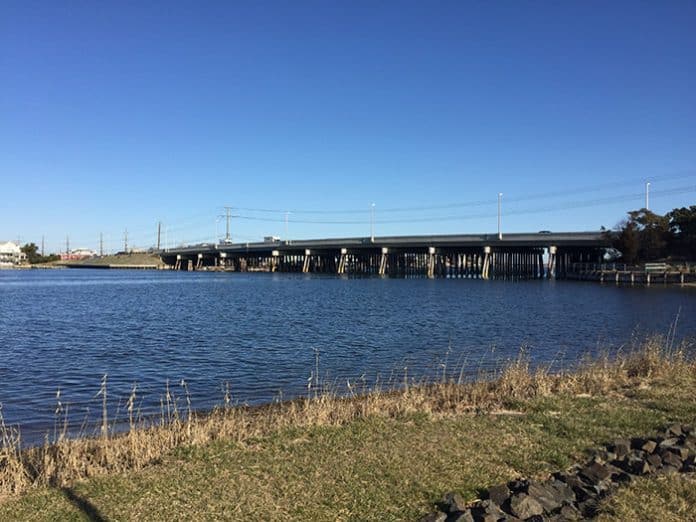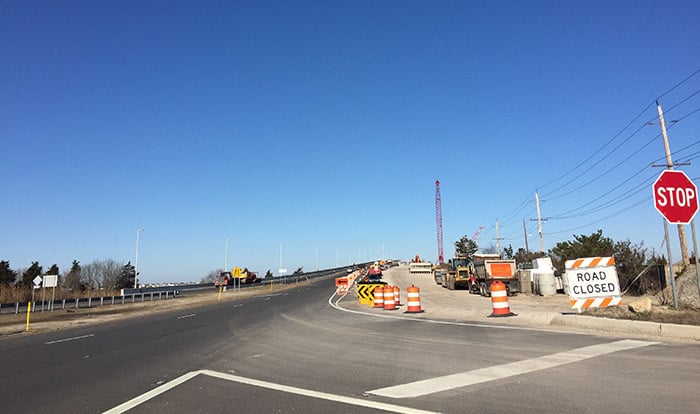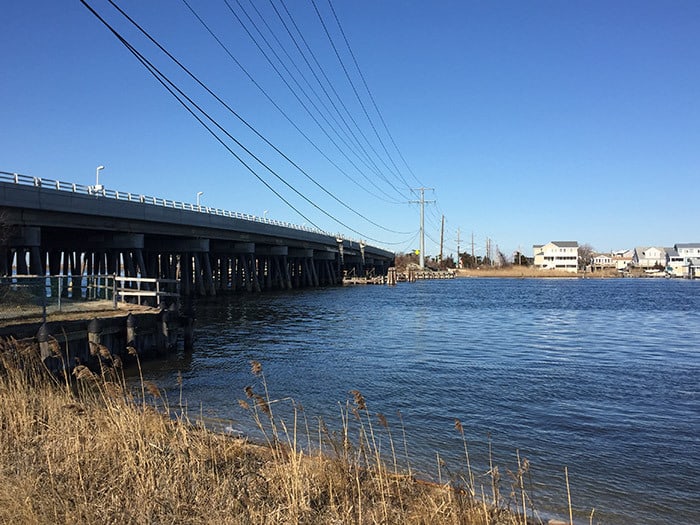
STAFFORD – The Route 72 Manahawkin Bay Bridge that connects Long Beach Island and the mainland has been undergoing construction for some time now.
Many residents wonder, when will this bridge construction be done?
“The federally-funded $350 million Route 72 Manahawkin Bay Bridge project began in 2013 and is expected to be completed in 2021. The three-mile long causeway links Stafford on the mainland with Ship Bottom on Long Beach Island, and it had become structurally deficient and functionally obsolete after nearly 60 years of service,” said Daniel Triana, Public Information Officer for the New Jersey Department of Transportation (NJDOT).
Triana noted that the term “structurally deficient” does not necessarily mean that bridge is unsafe, but rather points to the fact that the deck, superstructure or substructure of the bridge needs repair.
And “a “functionally obsolete” bridge is one that was built to standards that do not meet the current minimum federal requirements for a new bridge,” he explained. These “functionally obsolete bridges” have substandard or inadequate features.
Major Improvements
The major improvements to the bridge include “the construction of a new structure parallel to and south of the existing Manahawkin Bay Bridge, rehabilitation of the existing Manahawkin Bay Bridge, and the rehabilitation of three trestle bridges over Hilliard’s Thorofare, East Thorofare, and West Thorofare,” according to the NJDOT website.
NJDOT also noted other proposed improvements alongside these, including a 6-foot wide sidewalk on the westbound side of the northern bridge, bicycle lanes, improvements to the intersection at Route 72 and Marsha Boulevard, intersection improvements in Ship Bottom to help traffic flow, and drainage improvements in the case of heavy rainfall.
The proposed project will be a pair of twin bridges when completed, as opposed to the single two-way bridge.
“The twin bridge configuration does not increase capacity, as Route 72 will continue to have two lanes in each direction. However, the addition of shoulders will provide more efficiency by providing room for breakdowns and for emergency vehicles to pass unobstructed by traffic,” explained Triana. “The shoulders increase operational redundancy, safety, and improve the means of egress in the event an evacuation from the island is ever needed in the future.”
Triana also noted that the changes to the Marsha Boulevard intersection will include the addition of a third lane in each direction on Route 72. This will “increase the number of cars that get through the traffic signal, which will help ease congestion,” he said.

Construction Phases
The project is being carried out by five separate construction contracts.
“Schiavone Construction Co. is the contractor for contracts 2 and 3, which include the new Bay Bridge, and the rehabilitation of the East and West Thorofare Bridges. George Harms Construction Co. Inc. is responsible for contract 4 which includes the rehabilitated existing Bay Bridge, Hilliards Thorofare Bridge, and new bulkheads. C. Abbonizio Contractors, Inc. is responsible for contract 5, which includes environmental mitigation and public access improvements on Cedar Bonnet Island,” said Triana.
Contract 1 includes operational and safety improvements in Stafford Township around the Marsha Boulevard intersection, and improvements in Ship Bottom. This contract is not expected to go out to bid until 2019, however.
“The project includes wetland creation, mitigation for freshwater wetlands, and retrofit of two existing stormwater basins within the Barnegat Bay watershed and public access improvements,” it stated on the NJDOT website.
The state environmental assessment associated with the entire project produced a Finding of No Significant Impact. In a statement dated September of 2011, Ernie Blais of the Federal Highway Administration noted that “the Federal Highway Administration (FHWA) has determined, in accordance with 23 CFR 771.121, that the proposed project will have no significant impact on the environment.”
The entire timeline of the bridge began with a feasibility assessment phase that was completed back in 2007. Then, the approval of environmental documents, completed in 2011, showed no sign of significant environmental impact from this project. After that, the design phases and the construction phases began. The design phases were completed in 2017 and construction is expected to be complete by 2021.
“Construction of the new bridge parallel to the existing one over Manahawkin Bay was completed and opened to traffic in April 2016. The new bridge currently carries two lanes of traffic in each direction, while the existing bridge is being rehabilitated,” said Triana.

Expectations
When complete, the bridges will consist of two 13-foot-wide shoulders (made wider for bicycle accommodations) that border two 12-foot lanes of traffic. A six-foot wide pedestrian sidewalk was constructed adjacent to the outside shoulder in the westbound direction on the East Thorofare Bridge and the West Thorofare Bridge, and will be provided on the rehabilitated Manahawkin Bay Bridge and the Hilliards Thorofare Bridge, said Triana. There will also be a 10-foot multi-use walkway on Cedar Bonnet Island, to the west of the West Thorofare Bridge, for pedestrian and bicycle traffic.
“This design is consistent with the objective to build in strength or redundancy to better withstand future storms,” he said. “The existing causeway sustained relatively minor damage during Superstorm Sandy, but storm damage is a concern especially because Route 72 provides the only way for motor vehicles to enter or exit Long Beach Island.”
Amid all of these improvements, NJDOT will also be making public access to the waterfront easier, especially in areas where people can go to crab or fish. And if you love the light fixtures that illuminate the bridge across the bay at night, fear not; the “String of Pearls” lighting will be replicated on the outside of both bridges.
Sidewalks also will be provided along 8th Street and 9th Street, Barnegat Avenue, Central Avenue and Long Beach Boulevard in Ship Bottom as part of the pedestrian safety improvements and connectivity for the Island during the final phase of the project.
“The majority of the work has been on schedule and there have been no major obstacles during construction,” said Triana. “NJDOT has been working closely with local officials to ensure the impact to the community is minimized as best as possible.”






